Page 68 of 170
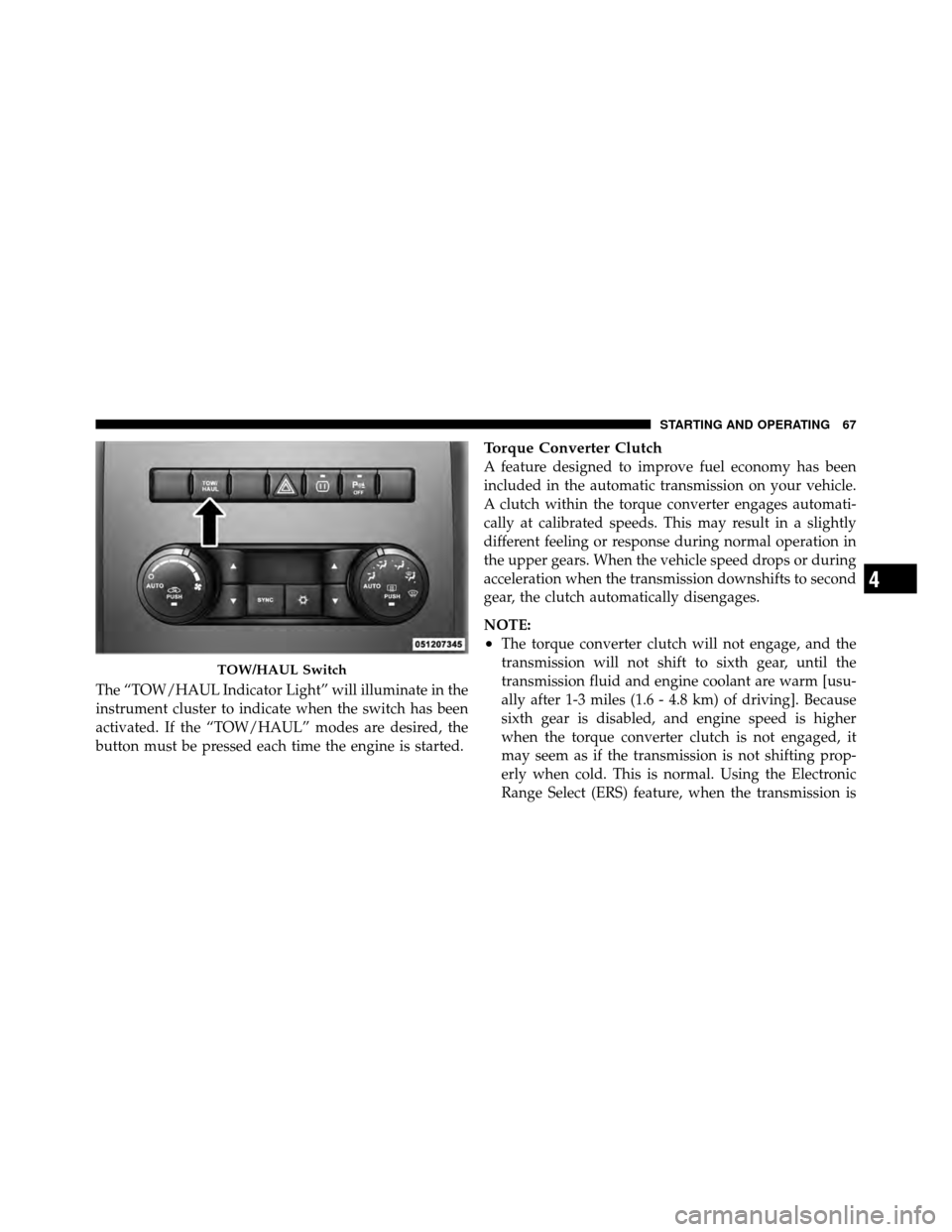
The “TOW/HAUL Indicator Light” will illuminate in the
instrument cluster to indicate when the switch has been
activated. If the “TOW/HAUL” modes are desired, the
button must be pressed each time the engine is started.
Torque Converter Clutch
A feature designed to improve fuel economy has been
included in the automatic transmission on your vehicle.
A clutch within the torque converter engages automati-
cally at calibrated speeds. This may result in a slightly
different feeling or response during normal operation in
the upper gears. When the vehicle speed drops or during
acceleration when the transmission downshifts to second
gear, the clutch automatically disengages.
NOTE:
•The torque converter clutch will not engage, and the
transmission will not shift to sixth gear, until the
transmission fluid and engine coolant are warm [usu-
ally after 1-3 miles (1.6 - 4.8 km) of driving]. Because
sixth gear is disabled, and engine speed is higher
when the torque converter clutch is not engaged, it
may seem as if the transmission is not shifting prop-
erly when cold. This is normal. Using the Electronic
Range Select (ERS) feature, when the transmission is
TOW/HAUL Switch
4
STARTING AND OPERATING 67
Page 73 of 170

•transmission has reached normal operating
temperature.
NOTE: If the vehicle is started in extremely cold tem-
peratures, the transmission shift schedule initially re-
stricts transmission operation in forward gear ranges to
third gear until the transmission fluid temperature rises
to a suitable level. During this condition, the ability of the
vehicle to accelerate under heavily loaded conditions
may be reduced. Refer to the “Note” under “Torque
Converter Clutch” in this section.
If the transmission temperature gets extremely hot, the
transmission will automatically select the most desirable
gear for operation at this temperature. If the transmission
temperature becomes hot enough, the “Transmission
Temperature Warning Light” may illuminate. After cool
down, the transmission will resume normal operation. The transmission will downshift from Overdrive to Drive
if the accelerator pedal is fully pressed at vehicle speeds
above approximately 35 to 40 mph (57 to 65 km/h).
When To Use “TOW/HAUL” Mode
When driving in hilly areas, towing a trailer, carrying a
heavy load, etc., and frequent transmission shifting oc-
curs, press the “TOW/HAUL” switch once to select the
“TOW/HAUL” mode. This will improve performance
and reduce the potential for transmission overheating or
failure due to excessive shifting. When operating in
“TOW/HAUL” mode, sixth gear is disabled and 2-3 and
3-4 and 4–5 shift patterns are modified. Shifts into
Overdrive (fifth gear) are allowed during steady cruise
(for improved fuel economy). When “TOW/HAUL”
mode is selected, the transmission may automatically
downshift into a lower gear to improve engine braking
performance when the throttle pedal is not pressed.
72 STARTING AND OPERATING
Page 74 of 170
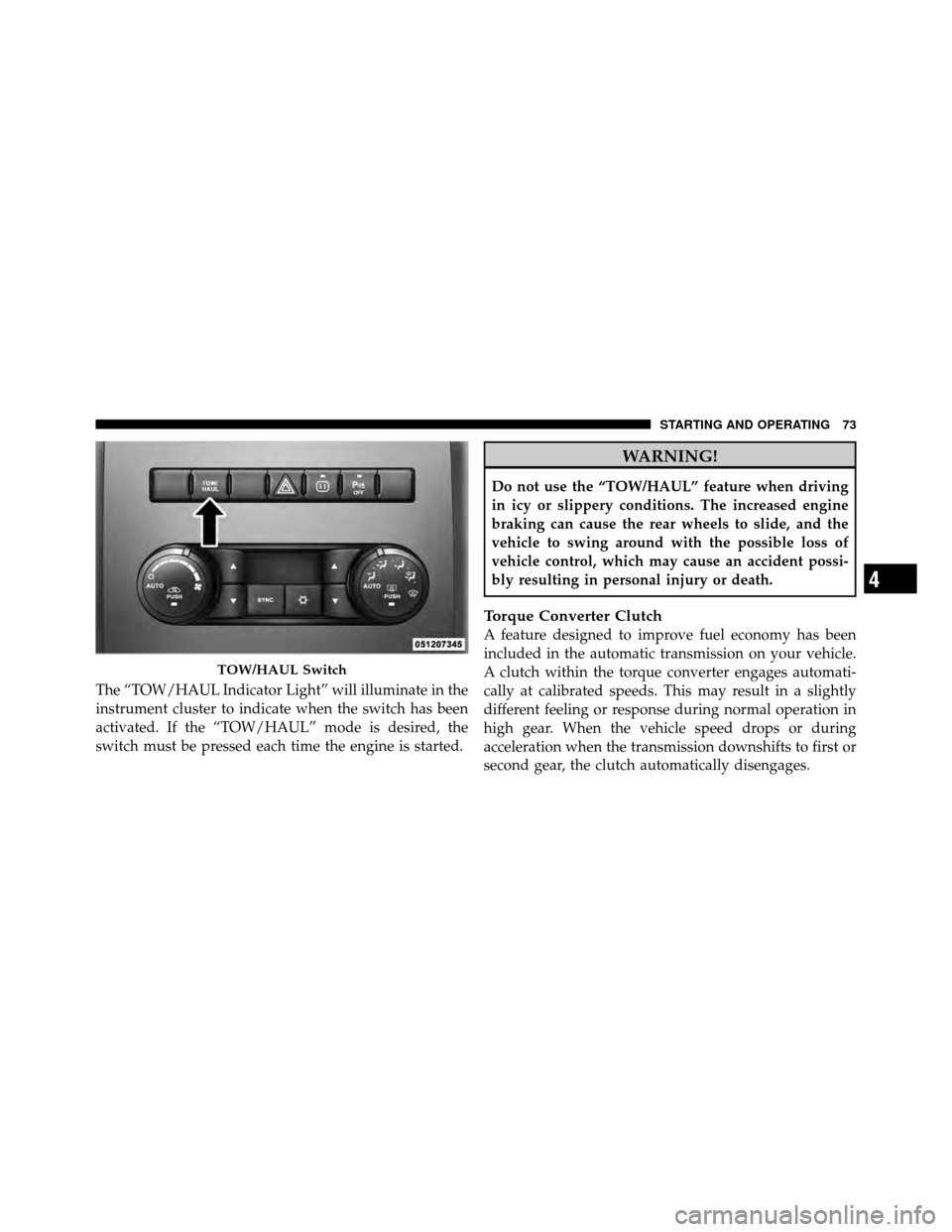
The “TOW/HAUL Indicator Light” will illuminate in the
instrument cluster to indicate when the switch has been
activated. If the “TOW/HAUL” mode is desired, the
switch must be pressed each time the engine is started.
WARNING!
Do not use the “TOW/HAUL” feature when driving
in icy or slippery conditions. The increased engine
braking can cause the rear wheels to slide, and the
vehicle to swing around with the possible loss of
vehicle control, which may cause an accident possi-
bly resulting in personal injury or death.
Torque Converter Clutch
A feature designed to improve fuel economy has been
included in the automatic transmission on your vehicle.
A clutch within the torque converter engages automati-
cally at calibrated speeds. This may result in a slightly
different feeling or response during normal operation in
high gear. When the vehicle speed drops or during
acceleration when the transmission downshifts to first or
second gear, the clutch automatically disengages.
TOW/HAUL Switch
4
STARTING AND OPERATING 73
Page 76 of 170

Shifting
Truck models with manual transmission are equipped
with a clutch interlocking ignition system. The clutch
pedal must be fully pressed to start the vehicle.Fully press the clutch pedal before shifting gears. As you
release the clutch pedal, lightly press the accelerator
pedal.
This transmission has a “creeper” first gear (L=Low)
which should be used to start from a standing position
when carrying a payload or towing a trailer. Damage to
the clutch can result from starting in second or third gear
with a loaded vehicle. An unloaded vehicle may be
launched in second gear. Use each gear in numerical
order – do not skip a gear.
You should use first gear when starting from a standing
position if under heavy load or when pulling a trailer.Recommended Vehicle Shift Speeds
To utilize your manual transmission efficiently for both
fuel economy and performance, it should be upshifted as
listed in recommended shift speed chart. Shift at the
Shift Pattern
4
STARTING AND OPERATING 75
Page 91 of 170
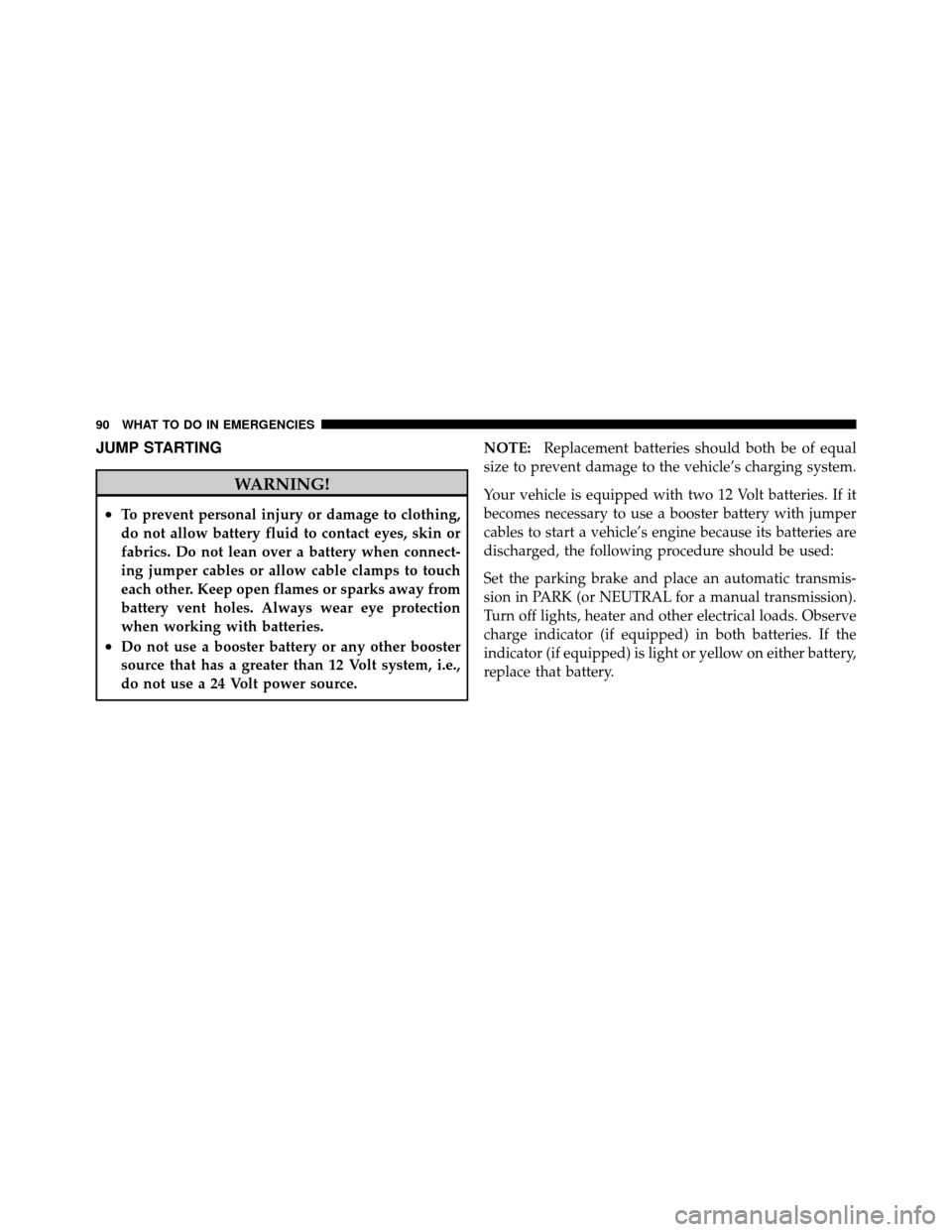
JUMP STARTING
WARNING!
•To prevent personal injury or damage to clothing,
do not allow battery fluid to contact eyes, skin or
fabrics. Do not lean over a battery when connect-
ing jumper cables or allow cable clamps to touch
each other. Keep open flames or sparks away from
battery vent holes. Always wear eye protection
when working with batteries.
•Do not use a booster battery or any other booster
source that has a greater than 12 Volt system, i.e.,
do not use a 24 Volt power source.NOTE:
Replacement batteries should both be of equal
size to prevent damage to the vehicle’s charging system.
Your vehicle is equipped with two 12 Volt batteries. If it
becomes necessary to use a booster battery with jumper
cables to start a vehicle’s engine because its batteries are
discharged, the following procedure should be used:
Set the parking brake and place an automatic transmis-
sion in PARK (or NEUTRAL for a manual transmission).
Turn off lights, heater and other electrical loads. Observe
charge indicator (if equipped) in both batteries. If the
indicator (if equipped) is light or yellow on either battery,
replace that battery.
90 WHAT TO DO IN EMERGENCIES
Page 105 of 170
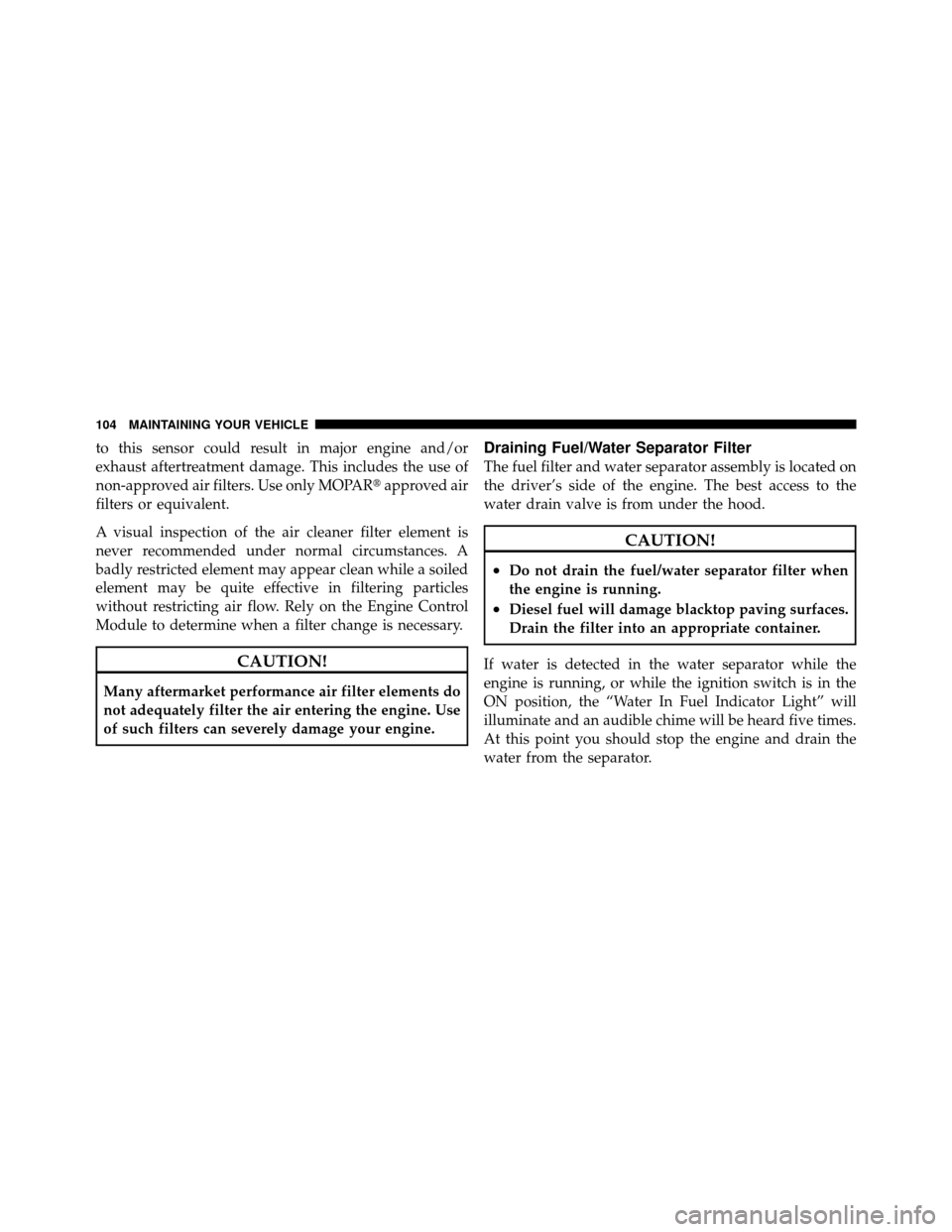
to this sensor could result in major engine and/or
exhaust aftertreatment damage. This includes the use of
non-approved air filters. Use only MOPAR�approved air
filters or equivalent.
A visual inspection of the air cleaner filter element is
never recommended under normal circumstances. A
badly restricted element may appear clean while a soiled
element may be quite effective in filtering particles
without restricting air flow. Rely on the Engine Control
Module to determine when a filter change is necessary.
CAUTION!
Many aftermarket performance air filter elements do
not adequately filter the air entering the engine. Use
of such filters can severely damage your engine.
Draining Fuel/Water Separator Filter
The fuel filter and water separator assembly is located on
the driver’s side of the engine. The best access to the
water drain valve is from under the hood.
CAUTION!
•Do not drain the fuel/water separator filter when
the engine is running.
•Diesel fuel will damage blacktop paving surfaces.
Drain the filter into an appropriate container.
If water is detected in the water separator while the
engine is running, or while the ignition switch is in the
ON position, the “Water In Fuel Indicator Light” will
illuminate and an audible chime will be heard five times.
At this point you should stop the engine and drain the
water from the separator.
104 MAINTAINING YOUR VEHICLE
Page 106 of 170
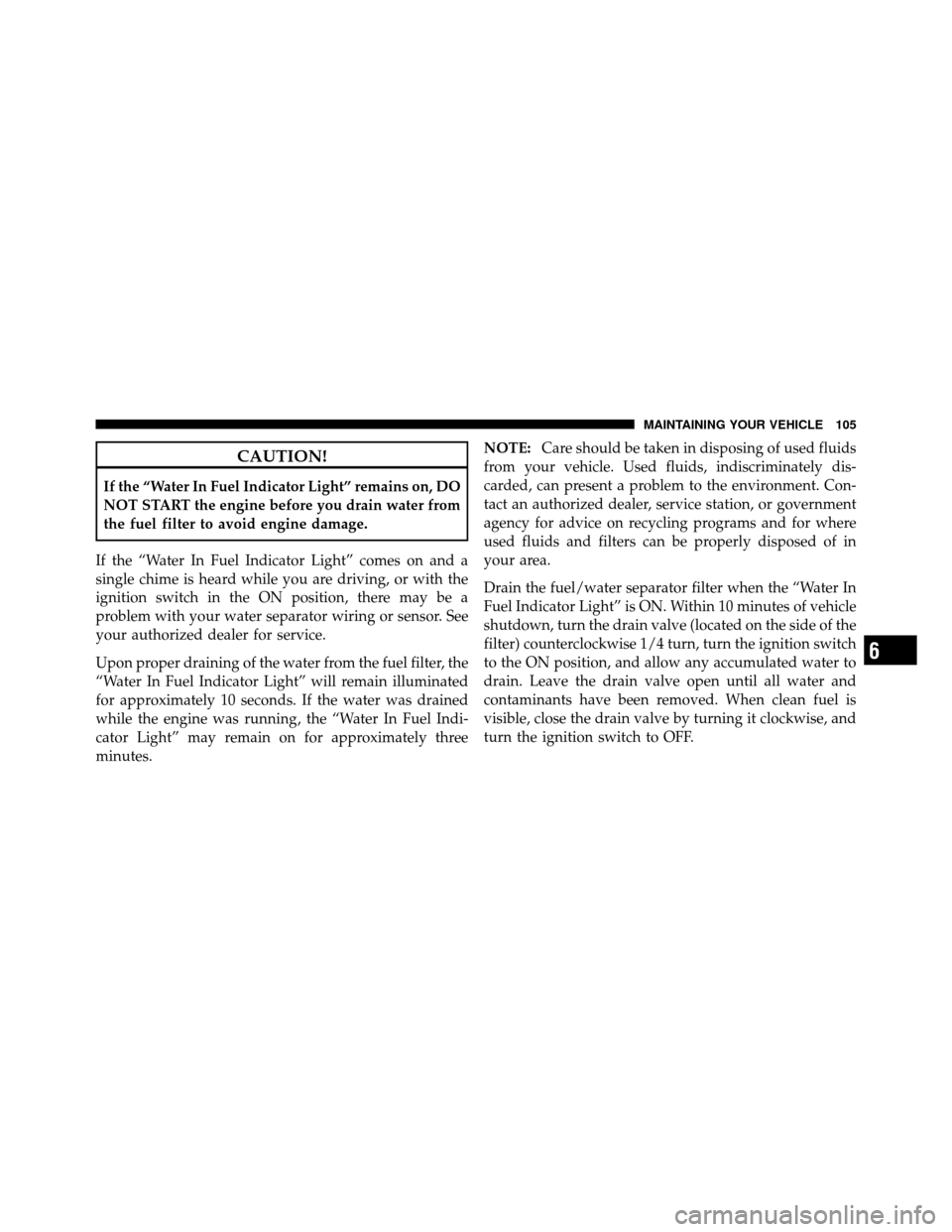
CAUTION!
If the “Water In Fuel Indicator Light” remains on, DO
NOT START the engine before you drain water from
the fuel filter to avoid engine damage.
If the “Water In Fuel Indicator Light” comes on and a
single chime is heard while you are driving, or with the
ignition switch in the ON position, there may be a
problem with your water separator wiring or sensor. See
your authorized dealer for service.
Upon proper draining of the water from the fuel filter, the
“Water In Fuel Indicator Light” will remain illuminated
for approximately 10 seconds. If the water was drained
while the engine was running, the “Water In Fuel Indi-
cator Light” may remain on for approximately three
minutes. NOTE:
Care should be taken in disposing of used fluids
from your vehicle. Used fluids, indiscriminately dis-
carded, can present a problem to the environment. Con-
tact an authorized dealer, service station, or government
agency for advice on recycling programs and for where
used fluids and filters can be properly disposed of in
your area.
Drain the fuel/water separator filter when the “Water In
Fuel Indicator Light” is ON. Within 10 minutes of vehicle
shutdown, turn the drain valve (located on the side of the
filter) counterclockwise 1/4 turn, turn the ignition switch
to the ON position, and allow any accumulated water to
drain. Leave the drain valve open until all water and
contaminants have been removed. When clean fuel is
visible, close the drain valve by turning it clockwise, and
turn the ignition switch to OFF.
6
MAINTAINING YOUR VEHICLE 105
Page 112 of 170

By simply driving your vehicle at highway speeds for as
little as 45 minutes, you can remedy the condition in the
particulate filter system and allow your Cummins�diesel
engine and exhaust after-treatment system to remove the
trapped PM and restore the system to normal operating
condition.
Exhaust Filter XX% Full
Indicates that the Diesel Particulate Filter (DPF) is ap-
proaching full.
Exhaust System – Regeneration in Process
Indicates that the Diesel Particulate Filter (DPF) is self-
cleaning. Maintain your current driving condition until
regeneration is completed.
Exhaust System – Regeneration Completed
Indicates that the Diesel Particulate Filter (DPF) self-
cleaning is completed. If this message is displayed, you
will hear one chime to assist in alerting you of this
condition.
Service Required – See Dealer Now
Regeneration has been disabled due to a system malfunc-
tion. At this point the engine PCM will register a fault
code, the instrument panel will display a MIL light.
CAUTION!
See your authorized dealer, as damage to the exhaust
system could occur soon with continued operation.
Exhaust Filter Full – Power Reduced See Dealer
The PCM derates the engine in order to limit the likeli-
hood of permanent damage to the after-treatment sys-
tem. If this condition is not corrected and a dealer service
is not performed, extensive exhaust after-treatment dam-
age can occur. In order to correct this condition it will be
necessary to have your vehicle serviced by your local
authorized dealer.6
MAINTAINING YOUR VEHICLE 111